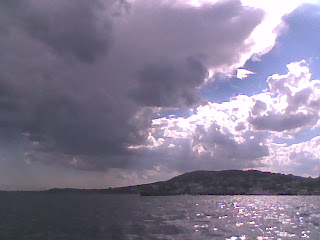Well. How long have people been driving past my masterpiece of half scraped nautical history and thought; "She's never gonna get around to fixing that old girl up."? I have had a few lovely Sunday afternoons, fuelled by a half decent late harvest, scraping back paint, filleting fish in her shade and generally just hanging out. She has been the robust source of dreams, fairytales and fey little laughs, probably for longer than I've known her.
Shark and I decided to go halves in her last year, and get her into the water by summer. He still owes me twenty bucks ... But he's always been a good, sound Mole to my Ratty and when he returns the hero, I shall shout him a dinner at Toad Hall. (That's a promise, Shark.)
 'Ratty and Mole' by Charles van Sandwyk
'Ratty and Mole' by Charles van SandwykThere is nothing more fun than messing around in boats, even of the land-locked variety. It is the dream, the idea of launching her into the water one day that holds her to me so. Only recently I saw the Pearl (well, her doppleganger) on an Agatha Christie movie; some chaps in boater hats skimming across the bay in a twenty foot carval-built speed boat with an inboard motor. I lost track of who-murdered-whom. It was just so exciting seeing the Girl!
"But she's got nice lines," I say to anyone who smirks at my folly. And they have to agree. She's the kind of boat that in her time was a leisure/racer, something for people who didn't know what to do with their money. At the same time she would hold her own in rough seas and carvals slide real nice and quiet through wine dark water.
But, on buying the Selkie, she has been supplanted. I am finally admitting what everyone else thought. I am not a carpenter. I am a ... um, well anyway. I am not a carpenter.
So the Pearl needs a new romantic. In two weeks she will be turned into a garden bed unless I can find someone with the same brain as mine, only more practical, who really wants to restore her.
The speccies; she needs 50% of ribs replaced (maximum), the planks are finest N.Z. Kauri and in good condition, she needs recaulking and a new quarterdeck (plywood and short cuts - easy). Then paint. Then motor. The transom will hold up or you can put in an inboard.
And the trailer goes with her. (Ever tried to get a half ton wooden carval off the ground and onto a trailer? I have. Believe me, once she goes on, you wanna keep her there.)
I'm pretty sure the Pearl was either built in Albany or spent most of her life here. She was built around the 1930's. Maybe I was just a momentary keeper, someone who keep her off the grass and dry rot for a year or so. I don't know. She's been gorgeous to have around. I'd like her to go to a good home.
And if she does end up a garden bed, or pond - it's a good home. These gardens are spectacular already. I trust in Mrs Yin and Yang's aesthetic chutzpah to make the Pearl even more beautiful. But I'd prefer to get the word out first.









